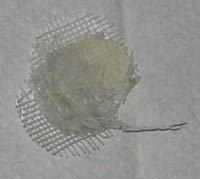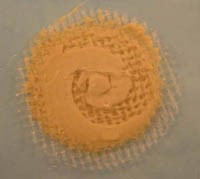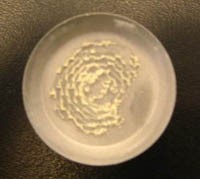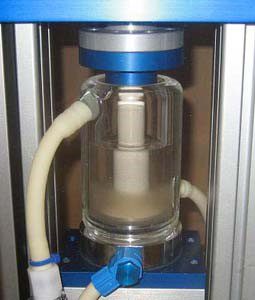Chewing FAQ
About the Chewing Apparatus, Chewing Machine, Dissolution Rate Tester and DRT
How can we perform Instrument Qualification and Operation Qualification (IQ/OQ)?
Will we get any further support with method development?
How can we arrange the supply of compressed air?
What is the use of Support Nets?
How many pair of jaws do we need?
Where can we get Dissolution Standard Gums?
What is the correct gap between the jaws?
What can we do when the jaws are stuck or difficult to remove?
Before Buying
Question:
Will FDA (Food and Drug Administration) or other authorities accept a file with data from this instrument?
Answer:
Yes, they will. It is adopted by the European Pharmacopeia 7.4, § 2.9.25 and is to be adopted by the US Pharmacopeia. Nicorette and Rugby Nicotine gums are registered in all countries with dissolution data from our Chewing Apparatus. In the European Pharmacopeia another machine is described. It differs in: poorer specifications and no default settings. It is not commercially available. It has some similarities to the FIA / Erweka Chewing Apparatus, but many points differ.
Advantages with the FIA / Erweka Chewing Apparatus are:
-
- It is well known by FDA and other authorities worldwide
- It gives reproducible results with low standard deviations
- It is sized to fit the analytical laboratory
- It is silent
- It has transparent dissolution cells for good visibility
- Operating height to achieve a comfortable working environment
- Easy to prepare and fast to reload and warm up for effective use
- It is well documented; examples of use
- Parameters easily changed
Good support is given for method development
Question:
How can we perform Instrument Qualification and Operation Qualification (IQ/OQ)?
Answer:
Normally this is done by the customer with minor support from the distributor. IQ/OQ documents for the Chewing Apparatus may be supplied by the distributor. They can also help you with the tests.
After Unpacking:
Question:
Will we get any further support with method development?
Answer:
You will get free expert support via e-mail. We respond as quickly as possible. You can also get paid support with method development, including chemical analysis, from our training and method development centers. Please ask for advice via i@fia.se.
Questions about technical details:
(Some of the questions below are discussed in the Manual. A good advice is to read the manual carefully before starting with any experiments).
Question:
How can we arrange the supply of compressed air?
Answer:
In the manual you will find the specification for compressed air needed. Many laboratories have compressed air connections in their buildings. For a 6-cell Chewing Apparatus, compressed air of 6 bar (84 psi) and minimum 100 liter per minute is required.
Normally a standard compressor is placed in a room, separated from the laboratory. Preferably it is sound insulated. In the laboratory a permanent installation is preferable made with a reduction valve and a manometer for read-out. A water trap is mounted at the reduction valve. These items can all be found in a standard hardware store.
For a 1-cell Apparatus a large tube with compressed air may be used or a compressor of “Silent Air”-type installed in the laboratory. All models from 2007 and onwards have a suitable reduction valve with manometer and water trap mounted on the carrier.
Question:
What is the use of Support Nets?
Answer:
Support Nets are needed for reproducible results. The gum is likely to slip off if it is not used. The nets are cheap and made of inert nylon.
Question:
How many pair of jaws do we need?
Answer:
It depends on how much you use the Chewing Apparatus. The operator replaces the used jaws with clean and qualified ones after each run. Batch wise cleaning is recommended. One batch of jaws is recommended to last for two weeks. One batch is then cleaned and qualified while another batch is being used. Needed is then two batches. We recommend for a 6-cell Chewing Apparatus 120 pairs of jaws and for a 1- or 2-cell apparatus 60 pairs. To start a smaller number of jaws can be tried.
Question:
Where can we get Dissolution Standard Gums?
Answer:
Currently samples of well-known medical gums as reference material are the best. On request we will suggest a suitable gum that is available in your territory.
Question:
What is the correct gap between the jaws?
Answer:
The gap depends on the volume of the gum and the formulation. The correct settings are found with the approach of test, adjust and retest. The in-vitro-profile should be correlated to the in-vivo-profile. Support Nets are used most of the time. A too narrow gap will often be destroy the nets (Picture 1). A too wide gap will result in poor mastication, a lost grip on the chewing gum and resulting in slow release of substance (Picture 2). The best result is when the chewing gum appears on the lower jaw (Picture 3).

Picture 1: Support nets destroyed by a too narrow gap.

Picture 2: The result of a too wide gap of support nets result in poor mastication.

Picture 3: When the gap is correct, the chewing gum is masticated well and often remains are left on the lower jaw after the dissolution test. This is the lower jaw after a well masticated Nicorette Mint chewing gum. The gap is set to 1.4 mm.
Question:
What can we do when the jaws are stuck or difficult to remove?
Answer:
Try to use a piece of dry paper tissue. It should be possible to remove the jaw with finger force. A special tool is also available. Never use a metal tool directly on the jaws. If you still want to use a metal tool is must be carefully covered with soft tape or cloth.
Question:
What is the Warming up Period?
Answer:
The Chewing Apparatus is a model of oral use and our body temperature is 37 degree Celsius. The Warming up Period is the time to reach this temperature. The jaws, nets and dissolution medium (saliva) are warmed up. Usually this time is less than 10 minutes. Chewing gums are made to be harder at room temperature and softer to chew. This is for packaging and the best chewing feeling. If the coating of the chewing gum has the active substance and this disintegrate during the Warming up Period and releases the active substance before mastication starts, special measures has to be taken to chew a cold gum. Please consult i@fia.se.

Picture 4: Liquid at the first sampling point, before mixing.
Sampling is usually made with a 1 ml pipette. Calculations to compensate for successively withdrawal of volume can made with the same mathematical methods as for a dissolution sequence. After sampling nets and gum are put back in the center of the lower jaw. No dissolution takes place when the gum is not masticated. The time that the sampling takes is of no importance to the dissolution test. Automatic sampling is possible. We don’t support it by default, but can be requested. A custom cuvette with a sampling tube can be used and samples are withdrawn. Prior to sampling, the liquid must be mixed to obtain a homogeneous solution.
Question:
Do we need to service the jaws?
Answer:
Yes! The chewing result depends on the jaws. During the development of the Chewing Apparatus, we have made hard efforts to ensure good quality of every aspect of the machine. We have tested many patterns on surfaces of the jaws. To get reproducible results and optimum performance of the machine, the jaws needs to be maintained. This maintenance should be done after each use of the jaws. We offer cleaning, re-blasting and qualification by skilled and educated personnel.
An Automatic Blaster Machine is sold separately. The sandblaster should be placed in a separate room since minor amounts of blaster sand can fall on the floor.
